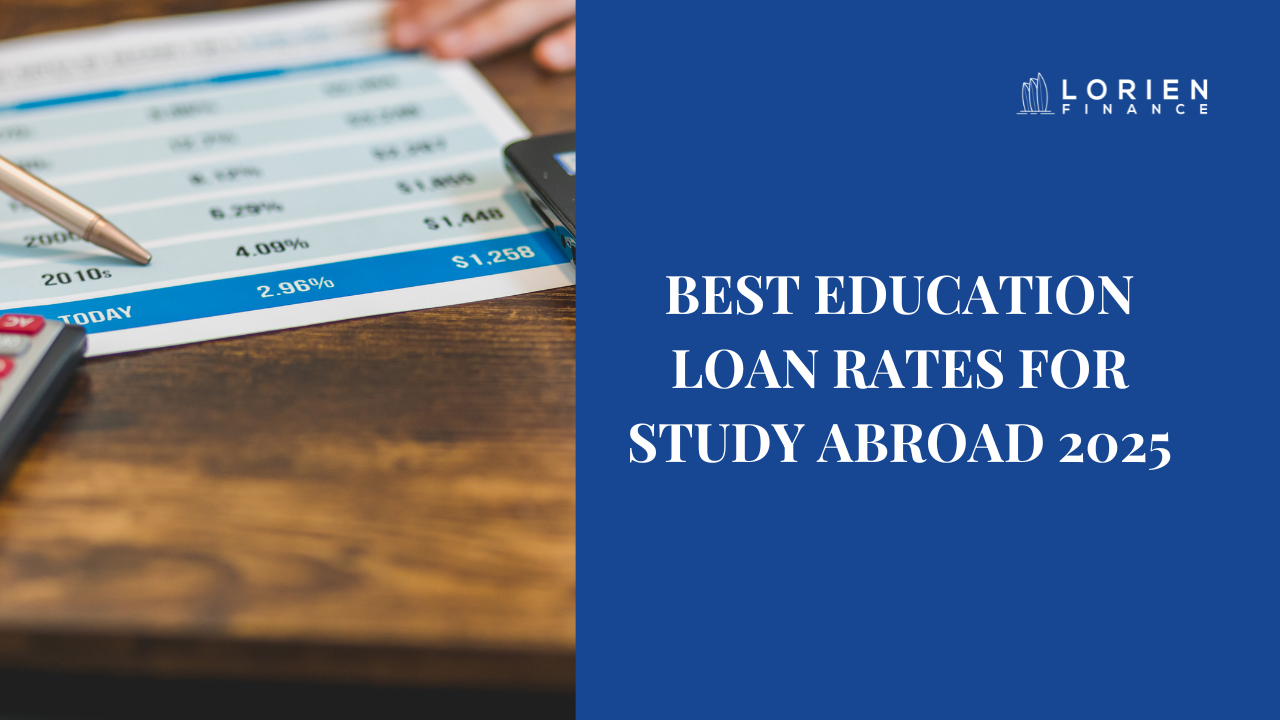Table of Contents
ToggleEvery year, thousands of Indian students face the same dilemma – their dreams of studying abroad seem financially out of reach without putting family assets at risk. The good news? Getting an education loan without collateral for study abroad has become more accessible than ever before, with multiple lenders now offering unsecured funding options specifically designed for international education. Understanding the right approach, documentation, and lender selection can make the difference between approval and rejection.
The landscape of overseas education funding has evolved significantly, especially for Fall 2025 aspirants. Banks and financial institutions have started recognising the potential of Indian students studying abroad, leading to more flexible policies around unsecured education loans. This comprehensive guide will walk students and families through every aspect of securing funding without collateral, from building the right financial profile to choosing between traditional banks and modern fintech solutions.
Understanding Education Loans Without Collateral in 2025
The concept of unsecured education loans has gained tremendous momentum in recent years. Unlike traditional secured loans that require property or fixed deposits as security, these loans are approved based on the student’s academic profile, chosen course, university reputation, and family’s financial stability.
What Makes Unsecured Education Loans Different
Banks evaluate multiple factors when considering applications for education loans without collateral. The primary focus shifts from asset value to future earning potential and repayment capacity. This assessment includes the student’s academic performance, the university’s global ranking, course employability, and the co-applicant’s income stability.
Most lenders offer unsecured education loans ranging from ₹7.5 lakhs to ₹1.5 crores, depending on the destination country and institution. The interest rates typically range from 9% to 15% annually, though competitive platforms like Lorien Finance’s Loan Fest offer rates starting as low as 3.39% through their network of 17+ global and Indian lenders.
Current Market Scenario for Study Abroad Loans India
The post-pandemic period has seen a surge in demand for international education, leading to increased competition among lenders. This competition has resulted in better terms for students, including relaxed eligibility criteria, faster processing times, and innovative repayment options.
Financial institutions now understand that students pursuing STEM courses, business programs, or professional degrees from recognized universities have strong employment prospects. This understanding has made lenders more willing to approve unsecured education loans for international students.
Building Your Profile for Loan Approval
Success in securing an education loan without collateral starts with building a compelling financial and academic profile months before the actual application.
Academic Excellence and University Selection
Lenders pay close attention to academic records and university choices. Students with consistent academic performance (above 60% throughout their academic journey) and acceptance letters from top-ranked universities have significantly higher approval rates.
The choice of university plays a crucial role in loan approval. Institutions ranked within the top 300 globally or those with strong industry connections and high placement rates are viewed favorably by lenders. Countries like the USA, UK, Canada, Australia, and Germany are considered safe destinations for educational investments.
Financial Profile Optimization
Building a strong financial profile involves more than just showing current income. Banks look for financial stability, credit history, and future earning potential. The co-applicant’s role becomes critical here, as their income, employment stability, and credit score directly impact the approval decision.
For families with self-employed members, maintaining proper financial records, filing regular income tax returns, and having multiple income sources can strengthen the application. Even small steps like maintaining a good relationship with the bank through salary accounts or existing loans can positively influence the decision.
Documentation Strategy for Success
Proper documentation can make or break an application for overseas education funding. Banks require extensive paperwork to assess risk and verify information provided by applicants.
Essential Academic Documents
Students need to provide complete academic transcripts from Class 10 onwards, standardized test scores (GRE, GMAT, IELTS, TOEFL), university acceptance letters, and detailed course curriculum. Any academic achievements, certifications, or relevant work experience should be included to strengthen the profile.
The statement of purpose for loan applications has become increasingly important. This document should clearly articulate career goals, explain the choice of course and university, and demonstrate how the education will contribute to future earning potential.
Financial Documentation Requirements
Financial documents form the backbone of any loan application. These include income tax returns for the past 2-3 years, salary certificates, bank statements, existing loan details, and asset declarations. For self-employed co-applicants, additional documents like profit and loss statements, balance sheets, and business registration certificates are required.
The presentation of these documents matters significantly. Organized, professional documentation creates a positive impression and demonstrates seriousness about the loan application.
Choosing the Right Lender for Education Loan Without Collateral
The choice of lender can significantly impact both approval chances and loan terms. Different types of financial institutions have varying risk appetites and evaluation criteria.
Traditional Banks vs NBFCs vs Fintech Platforms
Public sector banks typically offer lower interest rates but have stricter eligibility criteria and longer processing times. Private banks provide faster processing and more personalized service but may charge higher rates. NBFCs like Credila, Auxilo, and HDFC Credila specialize in education loans and often have more flexible policies for unsecured lending.
Modern fintech platforms have revolutionized the education loan landscape. Platforms like Lorien Finance aggregate multiple lenders, allowing students to compare offers and choose the best terms. Their Loan Fest initiative provides access to competitive rates starting at 3.39% from 17+ lenders, along with attractive rewards including MacBooks, iPhones, and study abroad travel kits worth ₹20,000.
Evaluation Criteria Across Different Lenders
Each lender has unique evaluation parameters. While some focus heavily on university rankings, others prioritize the co-applicant’s income or the student’s academic performance. Understanding these preferences helps in choosing the right lender and tailoring the application accordingly.
Some lenders offer specialized programs for specific courses or destinations. For instance, certain banks have tie-ups with universities that facilitate easier loan processing for admitted students.
Application Process and Timeline Management
Timing plays a crucial role in education loan approvals, especially for Fall 2025 admissions. Starting the process early provides flexibility and backup options if initial applications face rejection.
Optimal Application Timeline
The ideal timeline for applying for study abroad loans India begins 6-8 months before the intended start of the course. This timeframe allows for credit score improvement, documentation gathering, and multiple lender applications if needed.
Students should start researching lenders and their policies while preparing for university applications. Having a pre-approved loan amount can actually strengthen university applications by demonstrating financial readiness.
Managing Multiple Applications
Applying to multiple lenders simultaneously increases approval chances but requires careful coordination. Each application should be tailored to the specific lender’s preferences while maintaining consistency in core information.
Platforms that aggregate multiple lenders can simplify this process by allowing comparison of terms and simultaneous applications. This approach saves time and increases the likelihood of finding favorable terms.
Interest Rates and Loan Terms Negotiation
Understanding loan terms beyond just interest rates helps in making informed decisions and potentially negotiating better deals.
Components of Education Loan Pricing
Education loan pricing includes the base interest rate, processing fees, prepayment charges, and other associated costs. While the interest rate gets the most attention, other fees can significantly impact the total cost of borrowing.
Some lenders offer floating rates that change with market conditions, while others provide fixed rates for the entire tenure. Each option has advantages depending on market expectations and personal preferences.
Negotiation Strategies for Better Terms
Students with strong profiles often have room for negotiation, especially when dealing with multiple offers. Key negotiable aspects include processing fee waivers, interest rate reductions, extended moratorium periods, and flexible repayment options.
Building a relationship with the bank through existing accounts or family connections can provide leverage during negotiations. Being well-informed about competitive offers also strengthens the negotiation position.
Alternative Funding Options and Backup Plans
While traditional education loans remain the primary funding source, having alternative options provides security and leverage during the application process.
International Lender Options
Many universities have partnerships with international lenders who understand the specific needs of international students. These lenders often provide more flexible terms and consider factors beyond traditional Indian banking criteria.
US-based lenders like Sallie Mae, Discover Student Loans, and international platforms like Prodigy Finance offer loans to Indian students studying abroad. These options become particularly valuable when domestic lenders have restrictive policies.
Scholarship and Loan Combinations
Combining partial scholarships with education loans can reduce the overall borrowing requirement and improve approval chances. Many universities offer merit-based scholarships that can cover 25-50% of the total expenses.
Some lenders view scholarship recipients favorably as it demonstrates academic excellence and reduces their risk exposure. This combination approach often results in better loan terms and higher approval rates.
Managing Currency Risk and Repayment Planning
International education involves currency exposure that can significantly impact the total cost of education and loan repayment burden.
Currency Hedging Strategies
Currency fluctuations can increase loan burden substantially over the course duration. Some lenders offer natural hedging through loans disbursed in foreign currency, while others provide hedging products to manage this risk.
Understanding currency trends and planning for potential fluctuations helps in making informed decisions about loan structure and repayment planning.
Post-Graduation Employment and Repayment
Most lenders provide a moratorium period after course completion, allowing students time to find employment before starting repayments. Planning for this transition period, including understanding work permit regulations and job market conditions, is crucial for successful loan management.
Students should research employment prospects in their chosen field and destination country. This information not only helps in loan planning but also strengthens the loan application by demonstrating realistic repayment expectations.
Common Mistakes to Avoid
Learning from common mistakes can significantly improve approval chances and loan terms.
Documentation and Application Errors
Incomplete or inconsistent documentation is a leading cause of loan rejections. Students often underestimate the importance of proper document organization and professional presentation.
Timing mistakes, such as applying too late or not allowing sufficient time for processing, can jeopardize admission plans. Starting early and having backup options prevents such situations.
Unrealistic Expectations and Planning
Setting unrealistic loan amounts or choosing inappropriate lenders based on limited research often leads to disappointment. Understanding personal eligibility and matching it with appropriate lenders improves success rates.
Students sometimes focus solely on interest rates while ignoring other important factors like processing time, customer service quality, and repayment flexibility.
Leveraging Technology and Modern Solutions
Modern technology has simplified the education loan process significantly, making it more transparent and accessible.
Digital Platforms and Comparison Tools
Platforms like Lorien Finance provide comprehensive comparison tools that help students evaluate multiple lenders simultaneously. These platforms often have partnerships that provide access to exclusive offers and better terms.
The convenience of online applications, document upload, and status tracking has reduced the complexity traditionally associated with loan applications.
Expert Guidance and Support Services
Professional guidance can significantly improve application success rates. Experienced consultants understand lender preferences and can help tailor applications for maximum impact.
Many platforms provide end-to-end support, from initial counseling to loan disbursement and post-approval support. This comprehensive approach reduces stress and improves outcomes for students and families.
Securing an education loan without collateral for study abroad requires careful planning, proper documentation, and strategic lender selection. The key lies in building a strong profile that demonstrates both academic excellence and financial responsibility while understanding each lender’s specific requirements and preferences.
The evolving landscape of overseas education funding provides multiple opportunities for qualified students. With the right approach and proper guidance, the dream of international education can become reality without compromising family assets. Platforms like Lorien Finance, through initiatives like Loan Fest, continue to make this process more accessible and rewarding for Indian students.
Starting early, maintaining flexibility, and leveraging modern technology and expert guidance significantly improve the chances of success. The investment in international education, when properly planned and funded, opens doors to global opportunities and career advancement that justify the effort required to secure appropriate financing.
FAQs
What is the maximum amount available for education loan without collateral?
Most banks and NBFCs offer unsecured education loans ranging from ₹7.5 lakhs to ₹1.5 crores. The exact amount depends on the course, university, destination country, and the applicant’s financial profile. Premium institutions and high-ROI courses typically qualify for higher loan amounts.
How long does it take to get approval for unsecured education loans?
Processing times vary by lender – public sector banks typically take 3-6 weeks, while private banks and NBFCs can process applications in 1-3 weeks. Digital platforms and fintech lenders often provide decisions within 7-10 days. Starting applications 4-6 months before course commencement is recommended.
What credit score is required for education loan without collateral approval?
Most lenders prefer a credit score of 750+ for unsecured education loans. However, students with limited credit history can rely on their co-applicant’s credit score. Some lenders consider scores as low as 650 if other factors like university ranking and course prospects are strong.
Are there any processing fees for education loans without collateral?
Yes, most lenders charge processing fees ranging from 0.5% to 2% of the loan amount, typically capped at ₹50,000. Some lenders waive processing fees during special campaigns or for premium customers. It’s important to factor these costs into the total borrowing amount.
Can I prepay my education loan without collateral, and are there penalties?
Most lenders allow prepayment after a minimum period (usually 6-12 months). Prepayment penalties vary – some charge 2-5% of the outstanding amount, while others have no penalties. Checking prepayment terms before signing is crucial for future financial planning.
What happens if I don’t get a job immediately after graduation?
Most education loans include a moratorium period of 6 months to 1 year after course completion before EMIs begin. If employment is delayed, students can request extension of this period or restructure repayment terms. Some lenders offer income-based repayment options for such situations.
Do lenders consider online or distance learning programs for education loans?
Generally, traditional lenders prefer full-time, on-campus programs from recognized universities. However, some NBFCs and specialized lenders now consider high-quality online programs from reputed institutions, especially for professional courses like MBA or specialized certifications.
Can I change my course or university after loan approval?
Course or university changes after loan approval require lender consent and may affect loan terms. Significant changes might require fresh evaluation. It’s important to finalise academic plans before applying for loans to avoid complications during disbursement.








